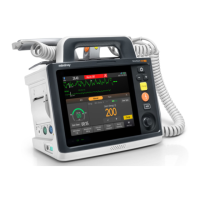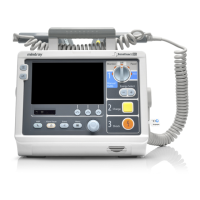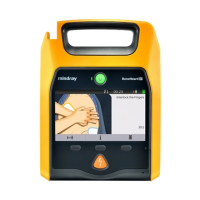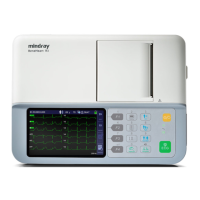1 - 2
• To avoid risk of electric shock, the equipment must only be connected to mains power with
protective earth. If a protective earth conductor is not provided, operate it on battery power, if
possible.
• Do not use the multiple portable socket outlets (MPSO) or AC mains extension cords. Insure that the
sum of the individual ground leakage currents does not exceed the allowable limits.
• Before putting the system into operation, the operator must verify that the equipment, connecting
cables and accessories are in correct working order and operating condition.
• Do not exclusively rely on audible alarms for patient monitoring. Adjusting alarm volume to a low
level or turning off alarm sound may result in patient hazards. Customize alarm settings according
to patient situations and keep patients under close surveillance.
• Physiological data and alarm messages provided by the equipment should not be used as the sole
basis for diagnosis or therapy decisions. They must be used in conjunction with clinical signs and
symptoms. Misinterpreting measured values or other parameters may result in patient hazards.
• Do not place the equipment or accessories in any position that might cause it to fall on the patient.
• Do not start or operate the equipment unless the setup was verified to be correct.
• Place and secure cables and tubings carefully to prevent from stumbling, entanglement and patient
strangulation.
• The software equipment copyright is solely owned by Mindray. No organization or individual shall
resort to modifying, copying, or exchanging it or to any other infringement on it in any form or by
any means without due permission.
• Disconnect the non defibrillation-proof devices from the patient during defibrillation.
• Make sure the synchronous input system is applied to this equipment and the input signal is correct
if necessary.
• Do not defibrillate a patient who lies on the wet or metal ground.
• Do not perform any functional check if the equipment is connected with a patient. Otherwise the
patient might be shocked.
• Always keep the patients under close surveillance when delivering the therapy. If there is a delay in
delivering a shock, the rhythm that has been analyzed as shockable may be converted to a non-
shockable rhythm, which may result in an incorrect shock delivery.
• For the treatment of patients with implantable pacemakers, place electrode pads or paddles away
from internal pacemaker generator if possible to help prevent damage to the pacemaker.
• Do not touch device connectors, recorder print head, battery connector or other live equipment if in
contact with the patient. Otherwise patient injury may result.
• Do not touch the patient and live parts simultaneously.
• If the accuracy of any value displayed on the equipment, CMS, or printed on a graph strip or report is
questionable, determine the patient’s vital signs by alternative means. Verify that all equipment is
working correctly.
1.1.3 Cautions
• Ensure that the equipment is supplied with continuous electric power during work. Sudden power
failure may cause data loss.
• Magnetic and electrical fields are capable of interfering with the proper performance of the
equipment. For this reason make sure that all external devices operated in the vicinity of the
equipment comply with the relevant EMC requirements. Mobile phone, X-ray equipment or MRI
devices are a possible source of interference as they may emit higher levels of electromagnetic
radiation.
• Always install or carry the equipment properly to avoid damage caused by drop, impact, strong
vibration or other mechanical force.
• Dry the equipment immediately in case of rain or water spray.
• Some settings are password protected and can only be changed by authorized personnel. Contact
your department manager or biomedical engineering department for the passwords used at your
facility.

